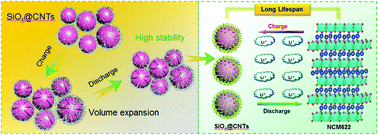An SiOx anode strengthened by the self-catalytic growth of carbon nanotubes†
Abstract
Modification using carbon nanotubes (CNTs) is one of the most important strategies to boost the performance of materials in various applications, among which the CNT-modified silicon-based anodes have gained considerable attention in lithium-ion batteries (LIBs) due to their improved conductivity and cycle stability. However, the realization of a close-knit CNT coating on silicon (Si) through an efficient and cost-effective approach remains challenging. Herein, a new in situ self-catalytic method by acetylene treatment is presented, in which, CNTs can be directly grown and knitted on the SiOx particles to construct a conductive additive-free SiOx@CNT anode. The in situ grown CNTs can not only enhance electric conductivity and alleviate the volume effect of SiOx effectively, but also mitigate the electrolyte decomposition with improved coulombic efficiency. As a result, an extremely high capacity of 1012 mA h g−1, long lifespan over 500 cycles at a current density of 2 A g−1 as well as a good performance in full LIBs with a working potential of about 3.4 V (vs. nickel-rich cathode) were obtained. The rationally constructed SiOx@CNTs with easy synthesis and high throughput will hopefully promote LIBs with energy density above 300 W h kg−1. This study opens a new avenue to prepare CNT-decorated functional materials and brings the SiOx-based anode one step closer to practical applications.



 Please wait while we load your content...
Please wait while we load your content...